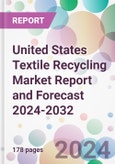Market Outlook
According to the report, the United States textile recycling market is projected to grow at a CAGR of 3.4% between 2024 and 2032. Aided by the increasing awareness and demand for sustainable and eco-friendly practices, the market is expected to grow significantly by 2032.Textile recycling involves the recovery of old clothing and textiles, transforming them into new materials or products. This process not only conserves resources but also minimises pollution, aligning with global sustainability goals. The United States, being one of the largest consumers of textiles globally, faces a significant challenge in managing textile waste, which has catapulted the textile recycling market to the forefront of environmental sustainability efforts.
The rising consumer awareness about the environmental impact of textile waste has led to a surge in the United States textile recycling market demand. Consumers are increasingly favouring sustainable fashion, driving brands to incorporate recycled materials into their products.
Government policies and regulations promoting recycling and sustainability have provided a significant boost to the textile recycling market. Initiatives aimed at reducing landfill waste encourage the adoption of textile recycling practices among businesses and consumers alike.
Innovations in recycling technologies have enabled the efficient processing of textile waste, including difficult-to-recycle materials. These advancements have expanded the capabilities of the textile recycling industry, making it possible to recover a broader range of textiles with higher efficiency.
The economic benefits of textile recycling, such as cost savings in raw materials for manufacturers and the creation of green jobs, contribute to the United States textile recycling market growth. The circular economy model, which emphasises the reuse and recycling of materials, supports sustainable business practices and economic development.
The market also sees opportunities in the rising trend of upcycling and the growing market for recycled textile products. As consumers become more environmentally conscious, the demand for products made from recycled materials is expected to rise, thereby, influencing the United States textile recycling market outlook.
Geographically, the market is distributed across various regions, with certain areas demonstrating higher activity due to more robust recycling infrastructure and consumer awareness. Urban centres, where consumer spending and waste production are higher, tend to have more developed textile recycling programs.
Market Segmentation
The market can be divided based on source, material, process, waste type, and region.Market Breakup by Source
- Apparel Waste
- Home Furnishing Waste
- Industrial and Institutional
- Others
Market Breakup by Material
- Cotton
- Polyester
- Nylon
- Wool
- Others
Market Breakup by Process
- Chemical
- Mechanical
Market Breakup by Waste Type
- Post-consumer Waste
- Pre-consumer Waste
Market Breakup by Region
- New England
- Mideast
- Great Lakes
- Plains
- Southeast
- Southwest
- Rocky Mountain
- Far West
Competitive Landscape
The report looks into the market shares, plant turnarounds, capacities, investments, and mergers and acquisitions, among other major developments, of the leading companies operating in the United States textile recycling market. Some of the major players explored in the report are as follows:- Unifi, Inc.
- Circ LLC
- Natural Fiber Welding, Inc.
- Lenzing AG
- Evrnu Inc.
- Ambercycle, Inc.
- Protein Evolution, Inc.
- For Days, Inc.
- American-Recyclers
- Martex Fiber
- Others
This product will be delivered within 5-7 business days.
Table of Contents
Companies Mentioned
- Unifi Inc.
- Circ LLC
- Natural Fiber Welding Inc.
- Lenzing AG
- Evrnu Inc.
- Ambercycle Inc.
- Protein Evolution Inc.
- For Days Inc.
- American-Recyclers
- Martex Fiber
Methodology

LOADING...
Table Information
| Report Attribute | Details |
|---|---|
| No. of Pages | 178 |
| Published | February 2024 |
| Forecast Period | 2024 - 2032 |
| Estimated Market Value ( USD | $ 142.8 Million |
| Forecasted Market Value ( USD | $ 186.6 Million |
| Compound Annual Growth Rate | 3.4% |
| Regions Covered | United States |
| No. of Companies Mentioned | 10 |









